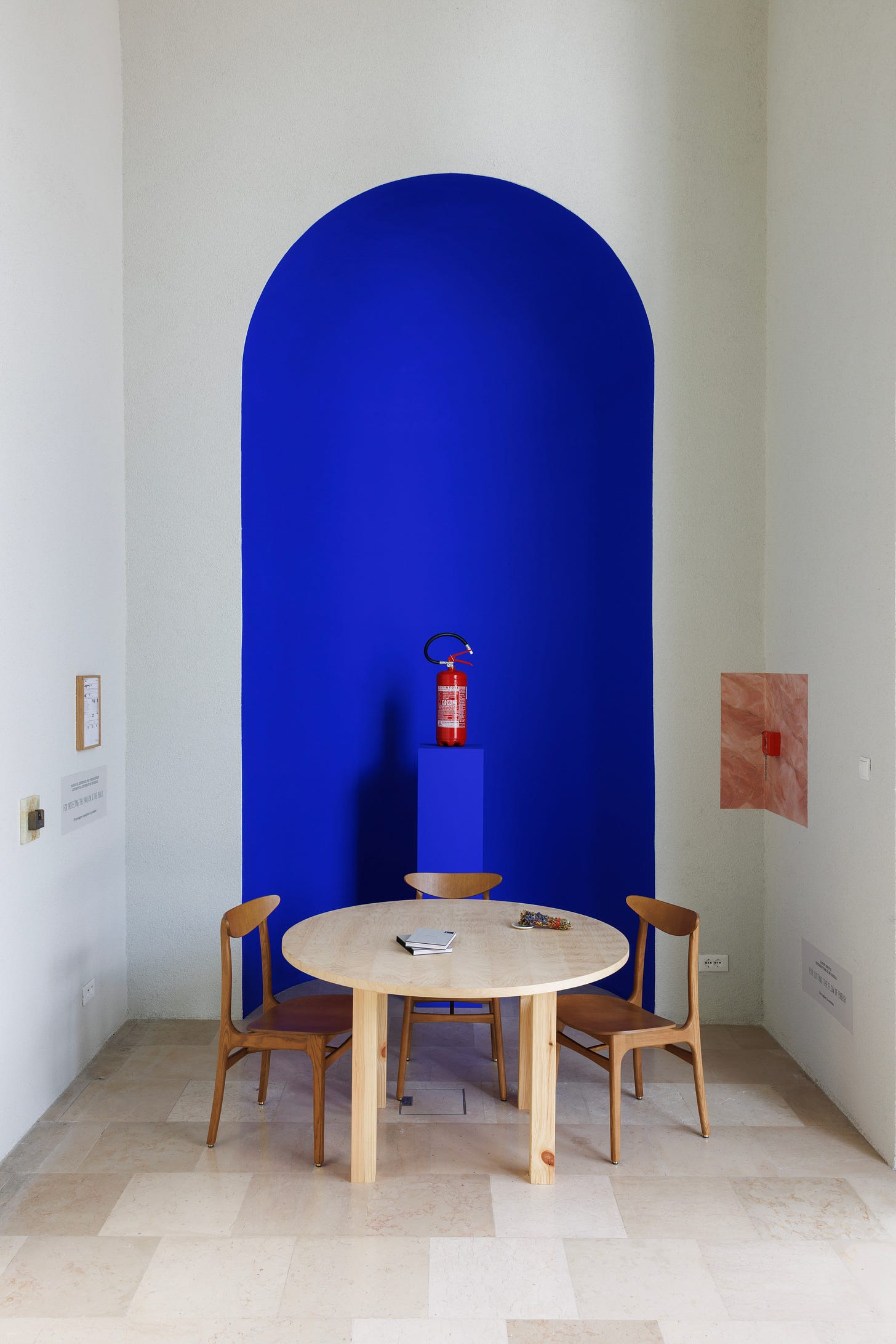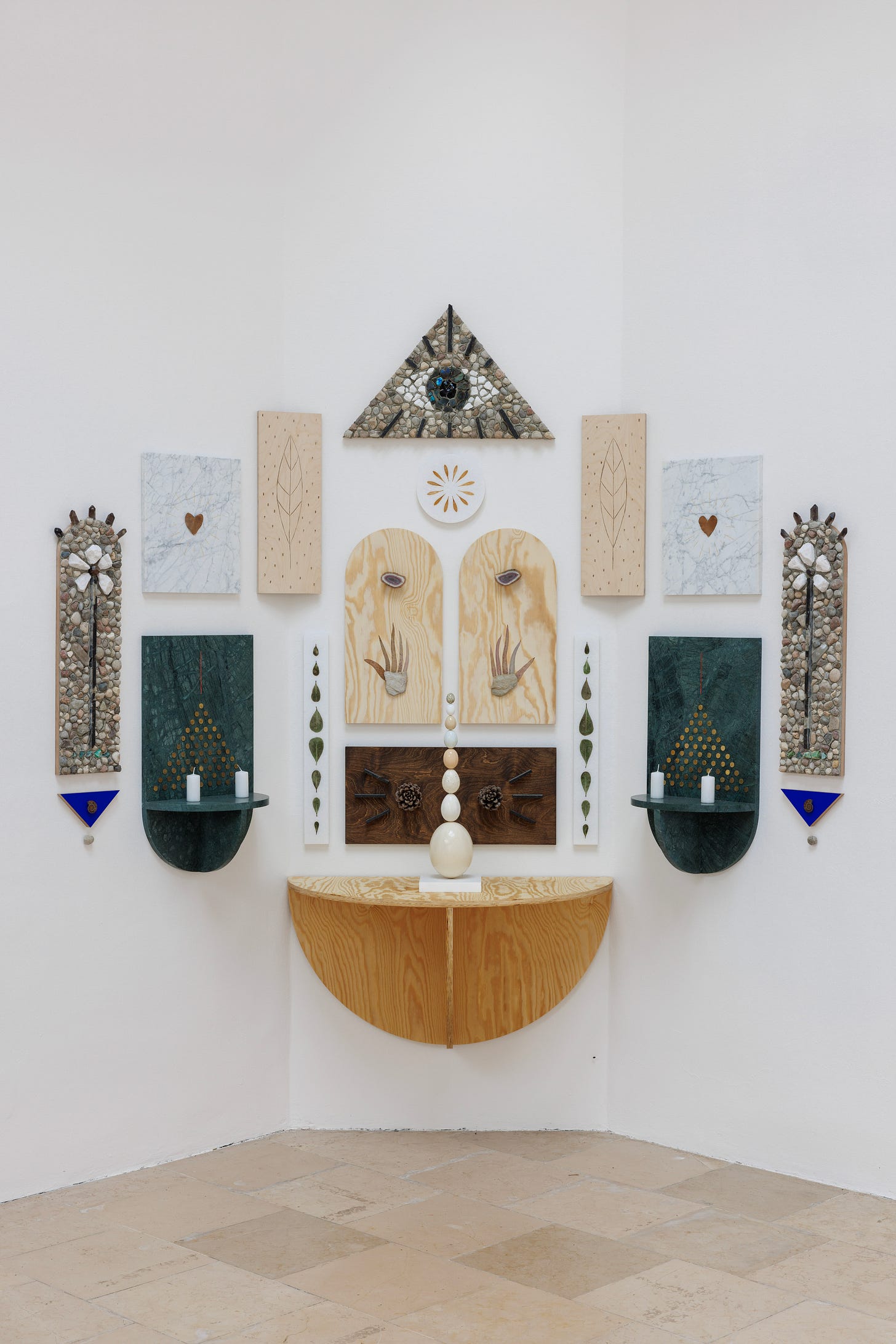Form Follows Belief. An Architecture of Superstition
My personal Golden Lion of the Venice Architecture Biennale 2025 goes to Poland: A deep dive into the concept of safety and its (ir)rationality.
Better Be Safe Than Sorry
Carlo Ratti’s (Gen X, Italian) very first sentence in the catalog of this year’s International Architecture Exhibition (Venice Architecture Biennale for the laypeople), is quite a hot take: “Architecture has always been a response to a hostile climate.”1 Surprisingly, he doesn’t highlight proactive creativity or an ambition to improve already benevolent surroundings. Carlo highlights architecture as a reaction to danger. He positions architecture not as sophisticated but as something primal instead. Maybe ironic for someone who loves to overengineer…
This is where the Polish Pavilion chimes in. Architect Maciej Siuda and artists Krzysztof Maniak and Katarzyna Przezwańska (all Millennial, Polish) offer a thought experiment: Is being safe and feeling safe the same thing?

The exhibition title Lares and Penates refers to Roman protective divinities:
“It seems [Lares] were originally the children of the gossiping nymph Lara (also known as Larunda), who revealed to Juno the affair between her nymph companion, Juturna, and Jupiter. Jupiter cut out her tongue to prevent her from revealing any more secrets and then had Mercury escort her to the underworld. During the journey, however, Mercury fell in love with her, and from their union the Lares were born , who became guardian spirits of a family and a home.” — Joshua J. Mark on worldhistory.org
Lares used to be the spirits of one’s ancestors or just household spirits. Penates, on the other hand, “were the spirits of the pantry and kitchen. It was the panes/penates who preserved food in the home and created a pleasant atmosphere in which to live.” In any case, the spirits were to be worshipped and respected to ensure a well-working home.
You can tell that the exhibition organizer is an art museum (Zachęta – National Gallery of Art) and that artists are involved. There’s no data sets, floorplans, or accurately sketched models. They do have architecture, but not in the way I’d expect: Dozens of evacuation signs arround the emergency exit (just in case you miss it); a shelter door leading into nowhere and held up by wooden scaffolding; colorful windowbars without windows, arranged to three sides closed into a column; wooden boxes filled with earth, egg shells, and coins. Maciej, Krzysztof, and Katarzyna draw attention to overlooked in-built details like safety switches, fuses, and fire alarms, sometimes adding a bright neon or marble background. Just as prominently displayed are a horseshoe, a birch trunk, smudge sticks, and a bottle with a message inside.

It’s not exactly architecture and superstition clashing here, although the culturally shaped practices and objects presented do stem from Polish and other regional beliefs. Speaking of architecture and superstition would be a judgment: The first is scientifical, rational, correct. The second is crazy, outdated, wrong. Instead, the exhibitors use the terms “security” and “a sense of security,” while leaving it up for debate which objects and practices belong in which category.
Both come together as equals here; there is no hierarchy. Each object comes with a handwritten neutral description: Motion Detector — To see in the dark; Blessed Candle — For protection from lightning; Roof — For protecting from weather; Radiesthetic Rod — For finding a spot to build a home.
Well, if that doesn’t sound familiar…
One cartoon visualizes how architectural elements around the world were directly shaped by beliefs: Roofs in China are bent because evil spirits only move in straight lines, flat stones jutting from chimneys are for witches to rest on in the UK, Hong Kong high rises have dragon gates so dragons can fly from the mountains to the ocean. I scoffed at number 4: The German Brandmauer wall that prevents fires from spreading. It’s also a political term that describes how democratic parties refuse to collaborate with ultra-right-wing groups and parties (like the AfD) to keep their harm in check. Brandmauer? I barely know her, says German politics, cuddling up with fascists right now…

Three fire extinguishers are prominently displayed in their own niche each. One against a crunchy ultramarine blue to the right of the entrance. On the left, the fire extinguisher is positioned above a visualization of firefighting history. The backdrop is a bright sky with golden rays. The only thing missing is an angelic choir. In the central room, one final fire extinguisher is displayed in a shell and marble grotto niche as if replacing the sculpture of a saint. So blasphemous. So cheekily satirical.
There’s another level to these fire extinguishers, eventhough the team confirmed that it’s not intentional: A visitor from Poland shared that fire extinguishers got a controversial political connotation since right-wing MP Grzegorz Braun put out a Menorah with one during a ceremony in the Polish parliament last year.
To Be Safe And Sound
Making people feel safe is equally important to providing a physically safe environment. Insecurity leads to paranoia, and paranoia leads to hostility, which results in even more insecurity. That’s how we get alienated, split societies with gated communities on one side and “troubled” neighborhoods on the other.

Considering a sense of security validates the need to feel safe emotionally. Think of the security camera — To see and be seen. Do cams actually make a house safer? Or do people simply sleep better knowing that there is one? Just in case? I look at the iPad that plays back the footage recorded by the camera right underneath the ceiling. To see myself delayed is such an odd out of body experience bordering on the paranormal. And if I want to, I can protect myself from the camera’s attentive gaze by sneaking into the fluffy fur-lined dead angle.
Speaking to supernatural forces to stop draughts, bring rain, and protect from harm used to be a societal default for dealing with physical insecurity. And then we were taught that we don’t need any of this no more: Science has deciphered the algorithm on which everything works. Not only do we know the laws and patterns of nature, we learned to manipulate them to our convenience. But this hasn’t led to more control and security: Playing God has thrown the scales off balance, and now we’re heading towards a yet unseen world of unpredictability. The more we try to control and alter it, the more it slips away. So we might as well start praying again.

At least that’s one reading of the show. If that conclusion was the intention, I’d be critical of it. Critical, because it would suggest that it’d be better to go back to simpler times, whatever that means — Mythical? Anti-intellectual? I don’t think that this pavilion pushes a reactionary narrative. I rather believe that the exhibition observes a growing need for validation in an uncertain time. I’m thinking back to my conversation with Mikołaj Sobczak (Millennial, Polish), who said that magical thinking is a response to life in an oppressive system. I’d add life in uncertainty. Instead of dismissing and ignoring that collective anxiety, Maciej, Krzysztof, and Katarzyna take the time to understand where it’s coming from. Acknowledging it is the first step to working with it.
Lares and Penates: On Building a Sense of Security in Architecture, until November 23, 2025, at the Polish Pavilion of the 19th International Architecture Exhibition, Venice.
National Pavilion of Poland
Giardini of La Biennale di Venezia
Venice
Website
Instagram: @polishpavilionvenice
As you’re reading this, I’m in Kosovo to see the Autostrada Biennale. Stay tuned!
See you soon!!!
Jennifer
The Gen Z Art Critic
Carlo Ratti: A Time of Adaptation. Exh.-Cat. of 19th International Architecture Exhibition of La Biennale di Venezia, 2025, p. 25


